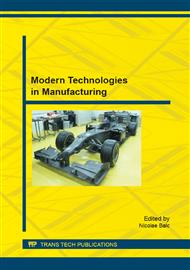[1]
Bere, P., Theoretical and experimental research on manufacturing and mechanical behaviour of polymer composite tubes, PhD thesis, Technical University of Cluj-Napoca, (2009).
Google Scholar
[2]
Decolon, C., Analysis of Composite Structures, Butterworth-Heinemann, ISBN-13: 978-1-903996-02-7, Paris, (2002).
Google Scholar
[3]
Gay, D., Matériaux composites, 4e éditions, Editions Hermès, ISBN 2-86601-586-X, Paris, (1997).
Google Scholar
[4]
Barbero, E.J. Introduction to Composite Materials Design. West Virginia University, USA, (1998).
Google Scholar
[5]
Berthelot M., Matériaux Composites. Comportement mécanique et analyse des structures, Editions TEC&DOC, Paris, 1999, ISBN 2-7430-0349-9.
Google Scholar
[6]
Ceclan V., Bere P., Borzan M., Grozav S., Borzan C., Development of Environmental Technology for Carbon Fibre Reinforced Materials Recycling, J Plastic Mater, 2013. 50 (2), pp.79-83.
Google Scholar
[7]
Jones, R.M. Mechanics of Composite Materials. Taylor and Francis, Philadelphia, (1999).
Google Scholar
[8]
A. Crai, H. Iancau, S. Grozav, C. Popescu, G. Onetiu, The Study Of Parameters Process Of The Injected Parts By Thermoplastic Material, The 20th International Conference DAAAM 2009- Danube Adria Association for Automation and Manufacturing, November, ISSN 1726-9679, 2009. Vol. 20 pp.3-4.
Google Scholar
[9]
Vasiliev, V.V., Morozov, E.V. Mechanics and Analysis of Composite Materials. Elsevier Science, London, (2001).
Google Scholar
[10]
Teodorescu, N., Stefanescu, M.F., Prodea I.M., Polymeric Materials Recycling/Processing Optimization, J Plastic Mater, vol. 51, no4, Pag. 347-350, (2014).
Google Scholar
[11]
Stefanescu M.F., Polymers melts pressure drop for non-isothermal flow through channels, J Plastic Mater, vol. 43, no: 3, pag. 254-25, (2006).
Google Scholar
[12]
Iancau, H., Bere, P., Borzan, M., Hancu L., Crai, A., The influence of reinforced materials and manufacturing procedures on the mechanical characteristics of polymeric composite materials, J Plastic Mater, vol. 45, no. 3, pag. 251-256, (2008).
Google Scholar
[13]
Păcurar R., Berce P., Research on the durability of injection molding tools made by selective laser sintering technology, in Proceedings of the Romanian Academy series a-mathematics physics technical sciences information science, vol. 14, no. 3, pp.234-241, (2013).
Google Scholar
[14]
Pacurar R., Pacurar A., Berce P., Balc N., Nemes O., Porosity change by resin impregnation in structures obtained by selective laser sintering technology, in Studia Universitatis Babes-Bolyai Chemia, vol. 57, no. 3, pp.5-13, (2012).
Google Scholar
[15]
Leordean, D., Dudescu, C., Marcu, T., Berce, P., Bâlc, N., Customized implants with specific properties, made by selective laser melting, RAPID PROTOTYPING JOURNAL, Volume: 21, Issue: 1, 2015, ISSN: 1355-2546, pp.98-104.
DOI: 10.1108/rpj-11-2012-0107
Google Scholar
[16]
Bere P., C. Neamțu., Design and manufacturing methodology for F1 nose car, 2014 International Conference on Production Research – Regional Conference Africa, Europe and the Middle East - 3rd International Conference on Quality and Innovation in Engineering and Management, Pag. 30-35, ISBN: 978-973-662-978-5.
Google Scholar
[17]
Neamțu C, Bere P, Methods for Checking the Symmetry of the Formula One Car Nose, Interdisciplinary Research in Engineering: Steps Towards Breakthrough Innovation For Sustainable Development Applied Mechanics and Materials, Issn: 1662-7482, Imane 2014, Doi: 10. 4028/Www. Scientific. Net/Amm. 657. 785.
DOI: 10.4028/www.scientific.net/amm.657.785
Google Scholar
[18]
Bere P., Neamțu C., Methodology for evaluate the form deviations for formula one nose car, Central European Journal of Engineering, 4(2)2014 • 148-154 DOI: 10. 2478/s13531-013-0158-x, Topical Issue: AMMA (2013).
DOI: 10.2478/s13531-013-0158-x
Google Scholar
[19]
G. Krolczyk, S. Legutko, Investigations Into Surface Integrity in the Turning Process of Duplex Stainless Steel, Transactions of FAMENA. 38 (2014) 77 – 82.
Google Scholar
[20]
G. Krolczyk, S. Legutko, P. Nieslony, M. Gajek, Study of the surface integrity microhardness of austenitic stainless steel after turning, Tehnički Vjesnik - Technical Gazette. 21 (2014) 1307 – 1311.
Google Scholar
[21]
Sabau, E. et al. Failure model for unidirectional fiber reinforced composites. J Plastic Mater 2010; 47; 215-218.
Google Scholar
[22]
P. Bere, P Berce , O. Nemeş, Phenomenological fracture model for biaxial fibre reinforced composit, Composites Part B: Engineering An International Journal Vol 43 (2012) 2237–2243.
DOI: 10.1016/j.compositesb.2012.01.073
Google Scholar
[23]
Miron A., Balc N., Popan A., Borzan C., Bere P., Studies on water jet cutting of 2D parts made from carbon fiber composite materials, The 6th International conference on Manufacturing Science and Education, MSE 2013, 12-15 June, 2012, Sibiu, Romania. Published in Academic Journal of Manufacturing Engineering, AJME-2013, Vol. 11, Issue 2, ISSN 1583-7904, pg. 87-92.
Google Scholar
[24]
Popan A., Balc N., Carean A., Luca A., New industrial applications of the abrasive water jet processing, The 3rd International conference on Computing and Solutions in Manufacturing Engineering, COSME'12, 25th-26th October 2012, Brasov, Romania. Published in Academic Journal of Manufacturing Engineering, AJME-2012, Vol. X, Issue 3, ISSN 1583-7904, pg. 97-102.
Google Scholar


